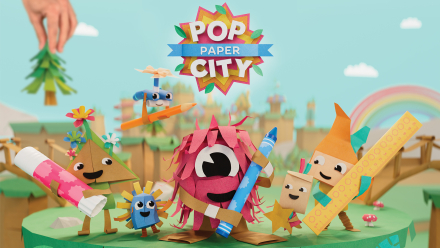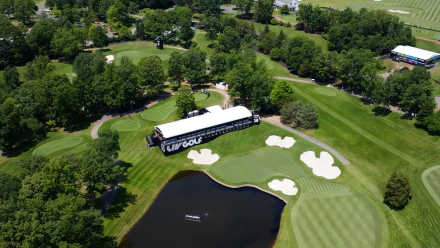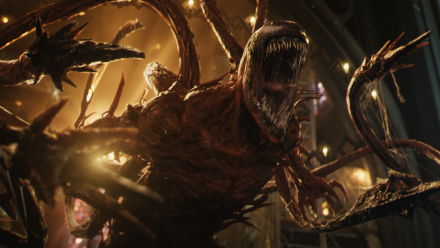Facts
Location
Germany, US, Canada, UK, Japan
Nemetschek Group Brands
Maxon
Scope
Growing up in the ‘80s Dylan Cole loved the feeling of going into other worlds so he immersed himself in comic books, “Star Wars” movies and books on the art of “Star Wars.” He was particularly drawn to the matte paintings and soon realized that’s what he wanted to do.
But even after graduating from UCLA with a fine art degree and getting an internship at Industrial Light and Magic, he still struggled to find work as a concept artist and matte painter in the aftermath of 9/11.
Cole’s big break came when he got to Prague to work on “The Sound of Thunder,” which he followed up by doing matte paintings for “Daredevil” and then he was off to New Zealand to work on “The Lord of the Rings” as a senior matte painter at age 23.
Things took off from there. Before long, Special Effects Artist/Designer and Filmmaker Robert Stromberg, who worked with Cole on “Chronicles of Riddick,” “The Aviator” and other films, got hired to be the production designer for “Avatar” and brought Cole on board as concept art director.
Eventually Cole got his first production design gig on “Maleficent” under Stromberg who by then was directing. In 2013, Jon Landau and James Cameron called about the “Avatar” sequels and the rest is history with Cole being one of two production designers for “Avatar” ever since.
We talked with Cole, who was recently nominated for an Academy Award for Best Production Design for “Avatar: The Way of Water” along with his co-designer, Ben Procter.
Tell us a bit about how your passion for matte painting led to where you are now.
Cole: I was first exposed to matte paintings in the Art of Star Wars books. I always loved the concept work of Joe Johnston and Ralph McQuarrie, but there is something magical about the matte paintings from Michael Pangrazio, Chris Evans and McQuarrie as well. I loved the simple and romantic idea that a painting you did could become a shot in a movie.
Later, as an intern at Industrial Light and Magic, I got to see professional artists doing their thing, which gave me a target to focus on. I knew nothing about Photoshop at the time, and I was sitting there so cluelessly. But I worked really hard that summer to teach myself how to work like they did.
How did you get to be on the “Avatar” team for all of the films?
Cole: Jon Landau and James Cameron could have hired anybody they wanted, but they like to keep it in the family so to speak for “Avatar,” so they brought Ben and I back in based on our experience from “Avatar” 1. We had each become production designers in our own right, so it was natural.
At first it was going to be three more sequels, which would be shot all at once. We had meetings with James, and he gave us rough descriptions of the village and these big mangroves, and it was up to us to figure it out. It was hard work and took a very long time. Metkayina Village was far and away the biggest challenge on the film.
We hired a small swat team of people to help us Steven Messing, John Park, David Levy and Fausto DeMartini. As we worked on scripts for all the films it became clear that “Avatar” 2 was heavy and had a lot of story.
So they chopped it in half and it became the second and third movies, and it was decided we would do the whole process: performance capture, live action, virtual camera, post, etc., for films two and three. Then, we’d do the whole cycle again for sequels four and five. But we did the lion’s share of design for all the films early on so we knew where we were going visually and thematically.
Say more about that process, please?
Cole: We did about a year and a half of performance capture, and then almost a year of live action plus another six months to a year of final virtual camera. It was a long process, but different things slowed us down, like Covid. And we were doing two and three at once, so it was a monumental task.
The “Avatar” team also took a break to become the “Alita: Battle Angel” design department. Any other time a film like that would be a monster, but it felt like a small, fun break compared to “Avatar.”
Production Design is a constant battle because you’re always trying to solve so many different things. First and foremost is the need to serve the script and story. But you also want to consider the higher level of the film’s visual philosophy and how to convey that. Of course, you also want everything to look cool, so it is a big juggling act and I’m proud of how we balanced that.
Explain the connectivity theme and tell us about some of your design concepts.
Cole: “Avatar” has a strong theme of connectivity. It is part of everything we design — the village is connected to the people, the sea and to itself in a way that serves the greater ideas of the film and Eywa (the guiding force of the Na’vi people). When you look at the village plan, it resembles a neural network with the maruis/dwellings being the neurons and the walkways being the synapses connecting them.
This network idea continues to the oceans, so the coral designs are sinuous and flow into one another. That helps the audience understand the intelligence behind the network that connects all of the living organisms on Pandora. It’s a fun action movie, but it has big ideas and themes, and people connect to it with its good emotional story.
The coral was very simple, just one big texture for the coral and sea floor and then a few simple coral alpha cards. I was very much leaning into the Mandelbrot fractal look for the bioluminescent coral shapes, trying to reinforce the idea of Eywa and intelligent design. The schools of fish above the bioluminescent reef were done using MoGraph along splines.
The Sea Wall was one of the first approved concepts I did in 2014. It is almost a living entity, with a series of upwellings that bring nutrient-rich water up from the depths to nourish the lagoon. The idea is that there is a rapidly calcifying plankton that accretes to make these structures. The sinuous shapes of the wall come from the waves crashing, and the terraces come from the upwellings.
I knew I was going to create the sea wall with photobashing and 2D fractal renders, so I just wanted to create a base of terraces. I made a very simple bean-shaped terrace and duped it around using C4D’s MoGraph to fill basic landscape shapes with many dupes to create some undulating terraces. Obviously, this was heavily painted over, but it was a good base.
How do you and Ben collaborate with James Cameron?
Cole: Production designers are in charge of the art department and the look of the film as a whole, so on big films like the “Avatar” sequels we are designing a whole world. I split things with my co-designer Ben, so I am all things related to Pandora — environments, cultures, creatures, etc., — and Ben is all things Earth — vehicles, human tech, weapons, etc.
All design goes through Jim, and it’s a fun process because he is such a good designer. He gets a good idea that may not be fully formed, and it is our job to bring it into focus. Sometimes that’s an iterative process where we figure it out by showing versions of things over months. Other times, it’s a jam session on a white board or with a Sharpie to throw ideas back and forth in real time.
Concept art is just a pretty painting until you turn it into functional sets. I’m responsible for sets and how they function, so we’d have virtual scouts walking empty stages exploring the set and we’d have chess pieces where we thought people or action would be. That way, we could check angles so we could hammer things out in context and then we’d bring in a group of actors to perform roles for blocking and performance capture.
Tell us about some of the personal work you do when you have time.
Cole: I have an ongoing series called Engine City with an order of monks in a sprawling city made up of gigantic engines and shapes that reference them. It is an allegory about man’s ongoing and evolving relationship with technology. It’s a great backdrop and premise for me to explore metaphors and visual ideas that interest me. Besides the epic cityscapes, I like doing very classical-style compositions and lighting.
I wanted a very graphic composition for Engine City: The First Snow, with large, simple shapes. I blocked it out in Photoshop and stuck to it very strictly. Once I have a composition I like, I always try to honor it and see it through. I think one of the hardest things to do is to maintain the spirit and energy of a sketch in a final image. A stiffness always creeps in, and I work hard to counteract that.
For Engine City: The Last Tree (below), I wanted this huge city-sized pit surrounding the last tree in this world. I imagined it being the tip of a large mountain that was completely covered by centuries of industrialization.
I also try and stay balanced and get outside and do some plein air painting. Breaking out the oils is a great way to work on traditional skills and think about color and composition without getting bogged down in details and just enjoy being outside in nature! I always learn something and kind of view it like a sport.
Are you already at work on the third “Avatar” sequel?
Cole: Yes, I’m cranking away on that now. It’s been performance captured and shot, and we are putting finishing touches on virtual sets and doing a lot of finalizing. As one of the production designers on the film and franchise, I’ve also been art directing multiple video games for years and I did a lot of poster art and a big piece of art for toy packaging. It’s been really fun to able to do all of that final art, which really puts a bow on everything we’ve created.
All stills courtesy of Dylan Cole.
_______________________________
Meleah Maynard
Writer/Editor – Minneapolis, Minnesota



